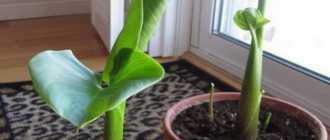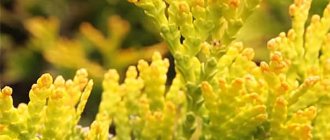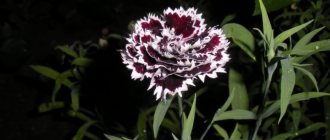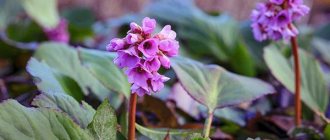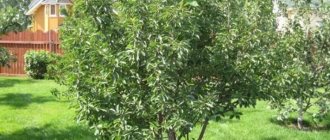Growing perennial Lupine from seeds
selectively bred flower , and its varietal qualities are best transmitted by dividing the mother bush. It is grown using seeds.
When to plant a flower
Planting seeds in open ground is available throughout the warm season :
How to plant in open ground
This is a fairly simple way to propagate a flower. First, a place is selected for permanent cultivation of Lupine bushes. The flower itself is absolutely not picky about the composition of the soil, but loose and fertile soil is more suitable for planting the plant.
Lighting prefers light - the lacy shadow of trees . You can plant seeds in rows or randomly, scattering them around the flowerbed.
The seeds are placed in shallow holes, well moistened with warm water and sprinkled with sand. In warm weather, the first shoots will show their noses in almost two weeks.
If the seeds are sown before winter, then do it at the end of October and there is no point in watering them, since the ground is already wet. In the spring, as soon as the snow melts, the first shoots will appear in a week.
Basic care requirements
In order for a plant to delight with its flowering, it needs :
- Timely watering in hot summers.
- Loosening the soil after rains.
- Weeding.
- Fertilizing the soil near the bush with potassium-phosphorus fertilizers.
Caring for seedlings after planting
When the first shoots appear, it is necessary to water in a timely manner in the morning or evening hours so as not to burn the young foliage.
Water the seedlings with warm, preferably rainwater.
In the first year, young bushes will not grow, as they will build up the root system and green mass of the bush. Therefore, it is only weeded and nitrogen fertilizers are applied for better growth:
Every four years the bushes must be renewed, replacing it with a young seedling, through any type of propagation.
Preparing the plant for winter
Preparing perennial Lupine for winter is not particularly difficult. When the leaf blades begin to turn yellow and droop in mid-October, they are completely cut off. In central Russia, the flower is not covered for the winter, as it is quite frost-resistant.
In northern latitudes, Lupine is covered with spruce branches or leaves from surrounding trees for the winter.
How to collect seeds
The seeds do not ripen simultaneously along the entire height of the flowering arrow. After each flower blooms, fruits are formed - beans. At the same time, in the lower part of the flower arrow they may already be ripe and have a light brown color, and in the upper part there may still be flowering buds.
Dry the seeds in a place with good air circulation and in the shade of trees.
Seeds collected with one's own hands remain viable for 6 years. In order not to lose the seeds, you can tie the ripening beans with gauze and then when the bean cracks, the seeds will not fall to the ground.
The seeds of this perennial are similar to legumes
Diseases and pests
If this does not help, treat with Actelik.
Care after flowering
Care after flowering comes down to preparing the bushes for winter. Seed pods and faded buds are removed, and the bush itself is hilled. After this, the bed is mulched: with hay or peat. This will be enough to prepare for winter.
When to collect seeds
Collecting seeds requires special observation. If they ripen, the seed pods will begin to burst and scatter seeds around them. Of course, they need to be collected before they start self-seeding. Since the seeds do not ripen evenly, closer to the end of the flowering period, it is necessary to carefully observe which flowers begin to dry out and cut them off; they should also change color to yellow.
Plant Facts
This flower has a large number of different varieties and therefore, by purchasing seeds, you can make a flowerbed with your own hands, planting Perennial bushes of different heights and beauty on it.
What does lupine look like?
The plant resembles a low, spreading herbaceous shrub with leaves resembling the open palm of a child and located on long, erect petioles.
Light green leaf plates grow from one root point, since the plant does not have a stem . The height of the bush is 55 cm.
When it blooms
The flowering period, depending on natural conditions, begins in May and lasts about one and a half months. The flowers are collected in a brush, shaped like a candle, up to 50 cm high.
Blooming Perennial reaches half a meter in height
To prolong flowering, you need to trim off fading inflorescences. Flowers come in different shades:
What varieties are there?
They all differ from each other not only in different shades of flowers, but also in the shape and height of the bush.
The most common varieties:
- Minaret - height reaches an average of 50 cm and has a conical flower structure.
Flowering of this variety begins in early June and lasts until September. The colors are varied.
- Fireworks - this variety has tall powerful bushes reaching a height of 120 cm.
Flowering begins in early summer and fragrant flowers bloom on tall candles: yellow, red and white.
- Lulu - the variety has miniature bushes, and begins to bloom in June, and if dried flowers are pruned, they bloom again in August.
Flowers of different color shades.
How tall does it grow
The height of the Perennial depends on the variety and ranges from 25 cm to 120 cm. It can also be added that in partial shade the plants grow more powerful than in sunny areas.
By selecting different varieties of perennial Lupine, the flowerbed can be planted in increasing height of the variety and then we will get a beautiful blooming wave .
Reproduction
Propagating a perennial plant is quite simple, using any of the methods below.
With this method, seeds are sown indoors to obtain seedlings. Seeds are sown in early March. To do this, you need to purchase containers for seedlings with holes to drain excess water.
You can buy the soil in a specialized store or make it yourself, taking identical parts:
Pour 1 cm of drainage into the bottom of the container and pour out the prepared nutrient soil. Lightly compact it and moisten it using bottom watering. The seeds are laid out on the surface and pressed lightly using the back of a pencil to a depth of 5 mm .
Cover the container with glass or a transparent plastic bag. After a while, greenhouse conditions are restored under the shelter, and this will facilitate the friendly germination of seeds.
After about 15 days, the seeds will sprout. Further care will consist of:
- Timely watering;
- Turning different sides towards the sunlight.
It is necessary to water with a tablespoon so as not to wash the seeds out of the soil.
By cuttings
This is a fairly simple way to propagate a perennial Lupine bush. Cuttings are lateral shoots that form in numerous quantities near the mother plant.
When they reach a height of 15 cm, they are planted in such a way that there is a green mass of the plant and a root system below . They are planted in a shady place with nutritious soil and watered vigorously, not allowing the soil around the seedlings to dry out.
If the weather is very hot, the young seedlings are mulched with hay.
In a month, the seedlings are ready to move to a permanent place of residence, but it is better to do this when the constant heat begins to subside, depending on the region - this will be the beginning of September.
How to sow?
Growing lupins is not difficult even for novice gardeners. The main thing is to plant the seeds correctly and provide the plant with proper care. Seed propagation involves two methods of planting beans - for seedlings in a special container and in open ground.
At home
Planting lupine seeds for seedlings is carried out in a nutrient substrate, which you can buy in a store or prepare yourself. To do this, mix turf soil, peat, sand in a ratio of 2:2:1 and thoroughly calcine the resulting mixture in the oven. The calcination time is about 20 minutes at an air temperature of at least 200 degrees. If it is not possible to heat the substrate, you can pour boiling water or a solution of potassium permanganate on it.
You can use seedling boxes, planting cassettes or peat pots as containers for seedlings. When using the latter, the proportion of peat in a homemade substrate is halved. The main condition should be the presence of a drainage hole through which excess water will drain. The soil is placed in the selected container, moistened and lightly compacted. Then the seeds are laid out on the surface of the substrate, pressed to a depth of no more than 2 cm and sprinkled.
Interesting Facts
- Lupine is a green manure that enriches the soil with microelements .
- The plant is also grown as fodder - an excellent food additive for pets.
- The plant has its second name “Wolf Beans”.
- If you squeeze oil out of Lupine, its composition will be close to olive oil.
- In America, Perennial seeds are used for food after they have been pickled.
- One hectare of the sown Lupine plant can easily replace 36 tons of manure spread over this hectare to fertilize the depleted soil.
- Lupine is used not only in landscape designs, but also in medicine. It is also used to make fish food .
This flower is very unpretentious and deserves to have a place in the flowerbed. Its beautiful candle flowers with a variety of colors and leaves reminiscent of palm leaves will be a wonderful decoration for your garden.
The plant often decorates gardens and homestead areas.
Read also: Remontant raspberry planting and care in open ground
For lovers of landscape design, we often write about the use of plants in garden decoration. Although Lupine is not included in this list, we recommend reading which plants are suitable for creating spring flower beds.
All parts of the plant cut in the fall must be embedded in the soil, and they will noticeably improve its chemical composition, since during the summer period the roots of perennial Lupine accumulate a lot of nitrogen.
Where do lupins grow?
Preparing thuja for winter
Planting and caring for a plant are important for any gardener. Let's figure out what soil and lighting are needed for perennial lupine.
Location and lighting
The plant is best planted in sunny or slightly shaded areas.
The flower grows best
in partial shade,
so it’s good if it grows nearby or in their shade, the plant will grow quickly and will delight you for a long time.
Soil for perennial lupins
The flower grows on virtually any soil, but loves loose, well-drained soil. This is a very unpretentious flower. The plant can also grow on poor soils as a green manure crop. Lupines love neutral, slightly alkaline and slightly acidic soils. If you planted flowers on alkaline soil, you need to add 5 kg of soil per 1 m2 of soil, otherwise the plant will turn yellow. If planted on acidic soil, it is necessary to lime the soil with lime flour with the calculation: take 5 kg of flour per 1 m2 of land. Liming must be done once every four years.
Did you know?
Americans eat pickled lupine.
Planting lupins in open ground and caring for them
Lupine is a herbaceous perennial, a beautiful large flower from the legume family. The popular name is wolf beans, because, unlike relatives such as beans or peas, the fruits of many types of lupine are poisonous. The plant is interesting not only for its decorative qualities - it has value as a green manure and a fodder crop. Planting lupine is not difficult, caring for it is simple, and growing it in open ground does not take much time.
Optimal landing times
The time for planting lupins depends on how the plant is planned to be grown. For example, the most favorable time for planting seeds for seedlings is the first week of March. If you plan to sow directly into open ground, then there are no clear deadlines for this. In such cases, you need to focus exclusively on the climatic conditions of the region, as well as the likelihood of recurrent frosts at night. So, in the southern regions of the country this may be the second ten days of April, while in the northern latitudes it may be the middle or even the end of May.
In addition to spring sowing, there is also autumn sowing, when seeds are sown in open ground a month before the start of winter - in the last week of October. Sowing seeds “before winter” has some advantages over spring. Firstly, the seeds are planted in soil that has warmed up over the summer, and secondly, in the winter they undergo a process of natural stratification, which significantly increases their germination in the spring. Seeds planted in autumn begin to bloom in the next season, around mid-August, while seeds planted in spring will bloom only next year.
Apart from the timing of the first flowering, there is no fundamental advantage of autumn sowing over spring sowing: lupine is an absolutely unpretentious plant and often grows so much that it involuntarily acts as a weed for noble crops.
Types and varieties
Of the more than 200 known species, no more than a dozen are cultivated in Russia, characterized by a wide range of flower colors.
- L. arborescens is a native of North America. The shoots are branched, straight, up to 2 m high. The flowers are white, yellow, red.
- L. white comes from Mediterranean countries. The species is annual, self-pollinating. Straight pubescent stems about 2 m tall, white flowers. The plant is resistant to drought and heat. Grown as an annual.
- L. yellow is a heat-loving annual. The flowers have a strong, pleasant aroma.
- L. dwarf forms compact, dense bushes and takes root easily and quickly. The color of the flowers is deep blue with yellow spots. In cold climates it is grown as an annual.
- L. multifolia is a native of North America. Reaches a height of one and a half meters, the flowers are colored in shades of blue, purple, white, and can be two-colored. Frost-resistant species, suitable for growing in regions with harsh winters.
- L. angustifolia (blue) grows up to 1.5 m. Large, fragrant flowers are colored in lilac, pink or white shades. An annual plant, it is considered one of the best green manures.
- L. Russell (Roussell) - a line of varieties and hybrids, bred on the basis of the developments of the English breeder George Russell. They are distinguished by their high decorativeness, combined with the natural qualities of the family.
- L. Hartwega is a compact annual, height up to 60 cm, cylindrical inflorescence shape.
Popular varieties of lupines:
- My Castel – blooms in early summer, height about half a meter, flower raceme length 35 cm, red flowers;
- Faust with flowers of various colors, height up to 80 cm, blooms in early summer;
- The Governor, white and blue flowers, flower raceme length about 30 cm;
- Abengludt, meter high, inflorescence length 40 cm, flowers of deep red color, frost-resistant;
- Minarette is about half a meter high, has a variety of colors, and begins to bloom in June;
- Neue Spielarten grows up to 1.5 m, the length of orange-pink racemes is about 40 cm;
- Prinzess Juliana is similar to the previous variety, but the flowers are pink and white.
Perennial varieties that bloom in mid-summer are able to bloom again. To do this, faded brushes are cut off immediately.
Varieties and varieties
Depending on the comfort of the environment, lupine can live as an annual, biennial, or perennial. Flower growers give preference to perennial species, which are successfully cultivated throughout central Russia. The most popular types include:
Narrow-leaved, or blue
The plant is short, no more than 50 cm in height. Despite the fact that this variety of lupine is called “blue”, the inflorescences can have, in addition to the characteristic shade, purple, pink, and white colors. One representative can have a huge number of large and lush peduncles, like Arctic lupine.
The plant is used as green manure; it is characterized by unpretentiousness, winter hardiness, grows quickly and does not require additional fertilizer. Some varieties, such as white lupine, do not require pruning or shaping. It is important to get rid of leafless stems and faded inflorescences in a timely manner.
When choosing lupine seeds, you should pay attention to their shape - it should be oblong oval and have a marble pattern.
Multileaf
A tall ornamental plant, reaching about 1.5 m in height, the root system deepens to the same distance, and is winter hardy. It is characterized by the size of candle-shaped inflorescences with a height of 35 cm. The most popular variety is red lupine. It blooms from June to August and likes to grow in open, sunny areas.
Decorative
Decorative varieties of lupine are used mostly for decorating summer cottages and are not used as green manure or pet food. Reaches more than 1 m in height, has a tap root system. This type of lupine has various shades of inflorescences, thanks to which it is actively cultivated in Russia
Yellow
A low plant, up to 1 m high. Lupine inflorescences are slightly reminiscent of a spike and are yellow or light orange in color. If we compare the culture with other popular varieties, then yellow lupine is more heat-loving. Since at least 12 degrees of heat is required for seedlings to appear, and when frost occurs again, the planting material dies. It is recommended to choose sandstones or sandy loams as a growing site.
White
White lupine is often used to decorate the local area and is also used as a forage crop. An annual plant that grows more than 1 m in height, it has a pubescent, straight stem with a large number of branches. Lupine buds are white in color, collected in thin inflorescences that stretch up to 30 cm. They grow quickly and bloom within 1.5 months after sowing. White lupine blooms for 90-150 days.
Low growing varieties
Low-growing varieties include dwarf lupine, the most common among gardeners. Its height varies from 20 to 50 cm. The leaves have a gray-green tint. Lupine blooms throughout the summer. It is recommended to start sowing in April. The plant does not require certain strict conditions of growth and cultivation and has a high germination rate.
Growing lupins in open ground
The cultivation technology is simple; all that is required is compliance with the rules of agricultural technology available to any gardener.
The flower grows well and blooms in open sunny or semi-shaded flower beds.
Areas where legumes or cereals previously grew are not suitable for planting lupins. Do not plant flowers next to cruciferous plants - they have the same diseases and pests.
Perennial lupins grow without any complaints on any soil, but loose, well-drained loam, neutral, slightly alkaline or slightly acidic, will be optimal for them. If the soil acidity level in the selected area does not meet the required level, corrective additives are added in the fall (5 kg/sq. m):
- for alkalization - peat;
- for deoxidation - dolomite or lime flour.
When to plant?
Growing from seeds involves the seedling method and direct sowing of seeds in open ground. The first option is recommended for use in regions with short summers, the second is suitable for southern regions.
In accordance with the chosen planting option, the timing of sowing seeds is determined:
- seedlings are sown in late February - early March;
- in open ground - in April, depending on weather conditions.
Growing seedlings
The process requires strict adherence to the rules below.
- The substrate for seeds is made up of sand, peat and turf soil in equal proportions.
Adding crushed dry lupine nodules to the soil mixture speeds up the emergence of seedlings.
- The seeds are pre-soaked with “Fundazol” (50%) - the procedure accelerates germination and at the same time protects against fungal diseases.
- The seedling container should be deep, with drainage holes. It is advisable to sow the seeds in separate cups so that the root system is not damaged during transplantation.
- The soil mixture is poured into seedling containers, moistened and furrows 1.5-2 cm deep are made. The seeds are laid out and sprinkled with substrate, the container is covered with polyethylene or glass.
- Crops are kept in a warm place. If this is not possible, it is recommended to mulch them with a layer of peat.
- Water as the top layer of the substrate dries. After the second watering, regular loosening of the soil begins. Loosen carefully so as not to disturb the seeds.
- Crops are ventilated daily.
- Loosening the soil and removing weeds is especially important in the first year, when the root system is formed in young bushes.
- The frequency and abundance of watering depend on the variety and composition of the soil. The general rule is that abundant watering is required for the first month or two after planting and during the formation of buds. Preferably rain water; tap water should be left for at least 24 hours.
- Monitor the root part of the plant. If it is exposed, add soil. From the second year, lupins are hilled to stimulate the growth of lateral roots. The flower will be strong, healthy, actively blooming.
- Tall bushes may require staking if they grow in a windy area.
- Faded flower stalks are promptly removed. A simple procedure has several goals - preventing self-seeding, preserving the decorative appearance of the bush, and stimulating re-flowering.
- Preparation for winter includes trimming flower stalks and old yellowed leaves, hilling, mulching with peat or sawdust.
- If the off-season is characterized by sudden changes in temperature, it is advisable to arrange an air-dry shelter; in extreme cases, the plantings are covered with film covering material.
Shoots appear in 2-3 weeks; seedlings are planted in flower beds after 20-25 days, when 2-3 strong true leaves have formed. It is not advisable to overexpose seedlings: the root system develops very quickly, and overgrown seedlings are much more difficult to plant.
Direct sowing of seeds
The land for direct sowing is prepared in the fall - it is dug up, deoxidizing or alkalizing additives, superphosphate and ash are added.
In the spring, holes or grooves up to 2 cm deep are dug for seeds, the seeds soaked in “Fundazol” are scattered and sprinkled with soil.
The optimal sowing time is April, the first half of the month for the south, the second half for temperate climates.
Pre-winter sowing is also practiced; it is carried out in the second half of October. The crops are mulched with a 2-centimeter layer of peat. Flowering will occur in the first year, approximately expected in August.
Seeds are also sown in summer, following the described technology.
How to plant lupine seedlings?
The grown strong seedlings are planted when the final warmth is established. Holes are dug according to the size of the earthen coma. The picking is carried out carefully so as not to damage the roots.
Seedlings are placed at intervals of 35 cm (for short and compact cultivars) to 50 cm (for tall and spreading ones).
Weak, poorly growing seedlings are not planted in flower beds: they have little chance, they are given a lot of space. They are either thrown away or found in a semi-shaded place under fruit trees.
Caring for lupine in open ground
Lupine is considered an unpretentious plant. In order for it to develop successfully and bloom regularly, follow the general rules of care.
Bushes are renewed every 4-5 years, since with age lupine gradually loses its decorative qualities and its ability to form full-fledged flower stalks decreases.
When and what to feed?
In the first year after planting, the plant does not need to be fertilized. Starting from the second year, every spring add:
- superphosphate – 10-20 g/sq.m. m:
- potassium chloride – 5 g/sq.m. m.
Read also: Hydrangea paniculata and tree-like planting and care in open ground
Complex mineral fertilizers are not recommended because they contain nitrogen, which lupins do not need.
Collection and preparation of seed material
There are several ways to propagate lupine in your garden, of which seed is the most accessible, although not the most effective. This is due to the fact that new specimens often do not inherit all the characteristics of the mother plant, and most seeds grow into a classic purple or pink lupine. This is especially true for those plants for the cultivation of which seeds from our own collection were used.
Therefore, in order for the flower to inherit the best varietal qualities and the desired color, you need to use only purchased seeds.
In general, the seed method of breeding lupins is a very creative, interesting process and allows you to get the most unexpected colors. In addition, with the help of seeds you can sow large spaces in a short time, which cannot be done in other ways.
If you decide to collect lupine seeds yourself, then you need to prepare for this event in advance. To do this, carefully monitor the beginning of fruit ripening and cut off the pods shortly before they begin to open. If there is no possibility of daily monitoring, then you can pre-tie several of the strongest, well-dried pods with a soft light- and breathable fabric into which the beans will be poured when the doors are opened. The collected seeds are removed from fabric bags, scattered on a sheet of paper, dried well and poured into a glass jar or fabric or paper bag.
The seeds do not lose their viability for 5-6 years.
If it is decided to plant the seeds in the spring, then to increase the percentage of germination, the upper shell of the seed is lightly opened using scissors or sandpaper. If neither one nor the other is at hand, then the integrity of the shell can be damaged in another way. To do this, the seeds are placed in the freezer and then immediately immersed in boiling water for 1 minute.
Due to a sharp temperature change, the hard shell cracks, and the seed gains access to water. Then the beans are laid out on one end of wet gauze, covered with the other end, placed on a saucer and placed in a warm place. From time to time the fabric is sprayed with a spray bottle, making sure that it is always damp.
Through the cuts, the seed gains access to water and quickly swells. Such seeds are distinguished by quick and friendly germination, while unprepared beans germinate for a long time and not at the same time.
Experienced gardeners recommend briefly placing them in a solution of potassium permanganate or any fungicide, which will ensure the destruction of harmful bacteria and fungi.
After most of the seeds have sprouted, they are mixed with powder prepared from old lupine tubers and planted in the substrate. This procedure provides the seedlings with the necessary bacteria that promote better growth and development of the flower. Before autumn sowing, no preliminary seed preparation is required.
Diseases and pests
Characteristic diseases - fusarium, brown spot, powdery mildew, gray and brown rot - appear for the following reasons:
- temperature changes;
- lack of lighting;
- waterlogging.
Fungicides are used to counteract. A preventive measure is the timely application of mineral supplements - superphosphate and potassium salt.
Insect pests of lupine are aphids, sprout flies, and nodule weevils, which are especially annoying during the period of bud formation. To combat them, insecticides are used, for example Aktaru.
To prevent diseases and pest attacks, monitor the watering schedule and regularly remove wilted leaves. Damaged parts of plants are promptly pruned and destroyed.
Reproduction methods
The main methods of propagation used for lupine are generative (seeds) and vegetative (cuttings, dividing the bush).
Seed method
The seeds are collected in the fall, after flowering again they have time to ripen. In varieties that bloom once per season, one peduncle is left.
The mature seed pod (pod) is yellow.
You should not wait for the seeds to ripen on the vine - lupine easily reproduces by self-sowing, bean seeds can scatter over the area from a gust of wind and fall out from the rain.
Harvest the pods when they begin to turn yellow. Without opening them, they are placed in bags, leaving free access to air. Ripe seeds will fall out of the pods on their own. After this, the valves are removed and the seeds are stored in a dry, dark place.
When collecting seeds, it should be taken into account that lupins are cross-pollinated and the likelihood of complete inheritance of parental qualities in new plants is low.
Cuttings
The good thing about this method is that the young plants completely replicate the mother plants.
When cutting in spring, a basal rosette is taken at the base of the stem. It is cut off with a piece of the root collar. In summer, lateral shoots that form in the axils of the leaves are used for cuttings. The procedure is carried out upon completion of flowering.
The cuttings are planted in a soil mixture with a high sand content in a shaded area. The first roots grow in 20-25 days - after this the cuttings are ready for planting in a permanent place.
Lupines grown from cuttings bloom in the current season.
Dividing the bush
The method is only suitable for shrub forms. Side shoots are separated from a 4–5 year old bush.
When to collect and how to store lupine seeds?
During the ripening period, the fruits crack and the seeds are dispersed by the wind. Collecting them after a break is inconvenient, so you should take care of this in advance. As soon as the beans begin to dry out a little, tie them with gauze. Then they will not crumble and after the fruits are fully ripened, they can be collected without any problems.
When the fruits turn yellow, they should be carefully placed in a plastic bag and stored in a dark, dry place.
Lupine seeds have different shapes, colors and the same smooth top cover, and retain the ability to germinate for 5 years.
Using lupins as green manure
Features of lupine that allow it to be used as green manure:
- the root system, going to a depth of 2 m, absorbs monohydrogen phosphates and lifts them into the upper layers of the soil, without depleting the turf layer;
- a developed root system maintains soil looseness and saturates it with oxygen;
- alkaloids contained in lupins contribute to soil deoxidation and repel many pests;
- like all legumes, lupine saturates the soil with nitrogen, taking it directly from the atmosphere.
To improve the soil, annual lupins are planted - white, yellow, narrow-leaved (blue). These same species help remove wireworm settlements.
Lupine varieties suitable for soil improvement:
- Degas, Gamma – white lupine;
- Crystal, Smena, Siderat 38 – blue lupine;
- Fakel, Peresvet, Grodno 3 – yellow.
Sowing of green manure is carried out in early spring or autumn, after harvesting. The beds are first cleared of weeds and crop residues. The distance between plants is maintained as follows:
- row spacing – 15-30 cm;
- in a row – 5-15 cm;
- The depth of the grooves is 2-3 cm.
Mow the plantings and incorporate plant residues into the soil after 8 weeks.
Multi-colored lupins are easy to plant and do not require special care. With minimal intervention from the gardener, flowers decorate the garden plot with candle inflorescences for a long time, pleasing the eye and attracting bees.
Features of the use of lupine in landscape design
Lupine is used in the production of decorative items, in the manufacture of cosmetics, hygiene products, especially soap and plaster.
The culture is excellent for decorating a garden plot; it looks best in single plantings, but can also be planted in compositions.
Tall varieties of lupine are used by designers to create an attractive background in flower beds, and low ones are used to form garden paths and borders. Planted along buildings and fences, it looks harmonious with other perennials.
Lupins - growing from seeds, when to plant, how to care
What types of lupins are there, when to plant them, what kind of soil this plant prefers, is it possible to grow them from seeds - let’s take a closer look. The beauty of these flowers inevitably attracts the eye and makes you want to plant them in your garden. The variety of colors is amazing; they can be white, yellow, red, pink, blue, dark red and even tricolor. They look great in company with other garden flowers and decorate flower beds, paths, and alpine slides.
In addition to the aesthetic effect, these plants improve the structure of the soil and enrich it with nitrogen. With all this, these flowers are not at all capricious; the process of growing them and caring for them will not cause you much trouble.
When do lupins bloom? This time comes with the arrival of calendar summer - in June, and lasts about a month. It is noteworthy that perennial representatives can produce color twice per season - in the second half of July and then in August.
There are approximately 200 species of this decorative flower, all of them are similar to each other (candle shape, leaves look like palm trees), and have minor differences in the structure of the inflorescences.
Leaf after the rain
Lupine is a plant from the legume family, can be either annual or perennial, has thick, long roots that reach about 2 meters deep. In addition to the work of the roots, the above-ground part also makes its contribution to enriching the soil. It is cut off and buried in the ground to a depth of about 20 cm, where it safely rots, thereby releasing useful substances into the soil and reducing acidity.
For all its decorative qualities, this plant is a forage and green manure crop.
Inflorescences and leaves, photo:
Features of lupine
Lupine has a taproot system, which in some cases can go 200 cm deep. On the surface of the roots there are small swellings that absorb nitrogen from the air, while saturating the soil under the bush with it. The stems can be herbaceous or woody, and the branches can be protruding, creeping or erect. Long-petioled, alternately arranged leaf plates have a palmate-complex shape; they are connected to the shoot by a leaf cushion with a long stipule. The apical racemose inflorescence consists of many flowers, which are arranged semi-whorled, whorled or alternate. In some species, the length of the inflorescences can reach up to 100 centimeters; the flowers can have different colors, for example: white, pink, purple, yellow, red, cream or all shades of purple. In different types of lupine, the seeds may differ in size, shape or color. For example, American beans are smaller than Mediterranean beans. After the beans dry, they crack and the seeds, which are very small grains, scatter around them. The culture is used not only to decorate flower beds, but also as green manure. The fact is that the foliage and shoots of lupine, rotted in the soil, become an excellent fertilizer. Fodder lupine is also widely cultivated.
Lupine as green manure and fertilizer
The grains, as well as the green part of the plant, are very rich in protein (40-50%), while at the same time the production of toxic bitter alkaloids is also high. According to the content of toxic substances in their composition, lupins are bitter, low-alkaloid, and sweet. Bitter varieties are used to fertilize the soil, but sweet and low-alkaloid varieties can be used as animal feed. This plant crop is very productive; white, yellow, and blue lupines (also called narrow-leaved lupine) are grown to obtain feed raw materials. Fertilizers are most often sown with perennial crops.
White lupine can reach a height of one and a half meters and tolerates drought comfortably - this is the most common variety.
Flowers of this species can be white, pale pink, pale blue. This is the best green manure for poor soil with a high level of acidity (deoxidizes it). It grows well and gains green mass even on infertile soil. Recommended for sowing on loam and sandy loam soils - it increases their fertility and can completely replace manure. The white roots are inhabited by bacteria beneficial to the soil; they convert poorly soluble phosphates into accessible forms. After removing the above-ground part of the plant (cutting), the roots decompose in the soil, turning into an easily digestible fertilizer. As a result, the soil is enriched with humus and organic components.
Yellow lupine is also an excellent green manure, it heals the soil, improves its structure, and increases fertility without any chemical influences. This crop is simply a record holder for saturating the soil with nitrogen; after its presence, 200-250 kg of nitrogen/ha remains on the field in the most acceptable form for future plantings. Yellow is sown quite early, and when it has formed beans, it is time to mow.
Lupine, as a green manure, not only nourishes the soil, but also loosens it quite well. As already mentioned, this plant has a developed, powerful root system. The roots branch in different directions - thus, the earth is loosened, the mineral compounds of the soil rise to the upper layers. This culture increases the drainage properties of the soil and promotes its reclamation. After sowing this crop, the soil retains moisture and air better. This plant also serves as a source of food for earthworms, which helps increase productivity and resistance to disease in the future.
The advantages of this plant as green manure:
- Long roots going deep into the soil, extracting useful elements from its depths;
- The ability to assimilate and process heavy micro- and macroelements of soil;
- Abundant yield, usefulness comparable to manure;
- Rapid maturation - the plant reaches the required condition 45-50 days after sowing the seeds.
Are lupins poisonous or not? As feed for farm animals, it acts as a source of ideal, easily digestible protein. This is the best option of all leguminous crops available today. The stems and foliage of the plant contain many useful components; the grains are a source of fat.
Read also: Corn planting and care in open ground in the middle zone
The disadvantage of this situation is the presence of toxic alkaloids in the plant.
For feeding animals, only yellow or white lupins should be used - they contain the least amount of toxic substances.
The blue species cannot be used as a forage crop. Usually the green part of the plant is used for feed mixed with other ingredients: silage, dung, artificial feed.
To prepare fodder and hay, the plant is cut at the stage of bud formation. Yellow lupine is mowed before the onset of the bean formation phase, white - without waiting for the end of its flowering.
In field ↑
Lupine diseases
Lupine is an unpretentious plant, but there are three insidious diseases that lie in wait for it at all stages of growth.
- Fusarium is manifested by the wilting of the flower during the formation of buds and flowering. Drying of the foliage and damage (rotting) of the roots are also observed.
- Phomopsis makes itself known by brown spots on shoots and leaf petioles. Excessive humidity only contributes to the development of the disease, as a result of which the entire flower is affected. The result is complete drying of the plant.
- Ceratophorosis scatters brown spots throughout the ground part, subsequently the flower dries out and loses its “fertility” (beans are not formed).
However, there is good news. The drug known to gardeners and gardeners, Fitosporin, quite successfully combats all these misfortunes. This product contains copper, is an environmentally friendly product, and is highly recommended for use.
This flower can be planted as desired - singly or in a group. It will be better if you place these plants at the very end of the bed or flower garden. Their tall stature can be used as a background, planting their shorter counterparts in front of them. It looks great in the company of many garden representatives, and its rich palette will look appropriate next to flowers of any shade. Now you know how lupins enrich the soil, growing them from seeds, when to plant them, how to care for and propagate them.
Perennial lupins - planting and care
This is a truly unpretentious plant that does not require any special growing technology. The most important thing is to know what kind of soil lupine prefers, as well as the period for planting it.
This flower feels equally good in shady or sunny places. If you want to achieve the highest levels of decorativeness, then place it in a shaded area of the site.
It loves slightly alkaline, non-acidic soil; with high acidity it will grow very frail, and in alkaline soils it can develop chlorosis. This situation can be changed if you first add dolomite flour (or lime acid) to the soil.
Perennial lupine is sown after the snow melts, around April. The plot of land on which the flowers will grow should be prepared in the fall. Before sowing, it is recommended to treat the seeds with foundationazole (50% solution). With this approach, you will be able to see the first flowers after 12-13 months (they usually bloom by May).
Seeds (beans), photo:
To obtain lupine seeds, several pods should be left on the plant, which will dry, ripen and provide the necessary seed material. During flowering, faded inflorescences are usually removed - this is necessary so that the growth of new flowers is not inhibited and self-seeding does not occur.
Leave a few inflorescences until they ripen completely (preferably in August); if you don’t have lupins yet, you can always buy the seeds at flower shops. The pod must be completely dry (no moisture allowed), and the extracted beans should also be thoroughly dried. It is best to store seed material in a glass container or in fabric or paper bags.
Lupine propagation - different options
If you are going to plant these flowers in your dacha, then know that annual lupine can only be propagated using seeds. Perennial species are available for propagation by seeds and cuttings.
Propagation of perennial lupine by cuttings
A cutting is a growth bud that is located on a rosette of leaves at the base of the plant. With the arrival of spring, these buds are carefully cut off and then rooted in open ground (choose a shaded area). At the planting site, it is very advisable to dilute the soil with sand to make it lighter. Another option is to select young shoots from the leaf axils after the plant has already flowered.
This planting source is rooted in the soil in the same way; the process of adaptation and establishment of the plant in a new place lasts approximately 35-40 days. After this time, the rooted seedlings can be transferred to flower beds, alpine hills, and flower beds. The main thing is not to exceed the recommended period so that the plant does not have time to take root thoroughly and take root. Lupine roots react extremely negatively to any intervention, so replanting will not lead to anything good. For the same reason, this flower is not propagated by dividing the bush.
Lupins from seeds - growing
First of all, you need to decide on the sowing time: it can be autumn or spring. Frost-resistant, self-seeding representatives of this crop are preferably planted in the fall. Around November, when the first frosts have already occurred, the seeds are buried a little (about 2-3 cm) into the soil and covered with a thin layer of peat. The distance between future bushes should be approximately 15 cm. Thus, with the arrival of spring you will see young growth, and by the end of summer it will give color. If you decide to plant plants in the spring, then choose the first weeks of April. Then, with the arrival of next spring, you will be able to admire the diversity of these beautiful flowers.
Shoots
Young bushes
Advice - for the best result, hard lupine seeds should be first scarified (slightly damage the top layer). To do this, experienced gardeners use one of the techniques described below:
- Scratch the bean shell mechanically - rub it with sandpaper or lightly cut it with a sharp object. During these steps, make sure that the inside of the seed is not damaged. After scarification, the seed should be soaked for several hours (so that it swells).
- Immerse the seeds in a temperature shock (sharp change in temperature) - place the beans in a clean thin cloth, then freeze them in the freezer. After removing them from the freezer, they should immediately be immersed in boiling water, briefly. Due to such a temperature contrast, the shell of the beans will crack, and the desired effect will be achieved.
- A bath of a chemical solution is a ten-hour soaking of seeds in a solution of bleach (10%) or potassium permanganate for 15-20 minutes. You need to take 2 or 3 drops of chlorine solution per glass of water. After exposure, the seed should be thoroughly rinsed with cold water. This method of scarification has an additional antibacterial effect if there is a threat of plant damage by fungi or other diseases.
Then we proceed to the next stage - lupins from seeds, growing in containers. To do this, pour soil into pre-prepared cassettes, disposable cups or separate plastic containers. Don't forget about the presence of drainage holes at the bottom!
The soil for these plants should include peat, turf, and clean river sand. It would not be superfluous to first disinfect it by frying it in the oven or microwave; scalding with boiling water is also suitable. Be that as it may, the soil for seedlings should be light.
Fill the pots with this soil, press it down a little, and water it with water at room temperature. After that, put the beans on top, deepen them a little, and water again (it’s better to use a spray bottle). Next, cover the containers with plastic wrap and take them to a place where it is warm and light.
We carefully monitor the level of soil moisture, water if necessary, and promptly remove condensation. The first sprouts should appear after about 2 weeks. At this stage, the film should not be removed yet; you can only water it daily and ventilate the sprouts (not for long). It will be possible to remove the “greenhouse” when the seedlings become stronger.
When spring comes into its own, it gets warmer outside, and your seedlings have 5 or 6 leaves, you can transplant the young lupins to a permanent place of residence. When planting, keep a distance between the bushes - 30-40 cm. Don’t waste time, remember the sensitive roots of the plant, replant them in open ground in a timely manner.
Dark red variety, photo:
Caring for lupine in summer
Preparing pears for winter and caring for autumn
As with caring for all flowers, in first-year lupine plantings it is necessary to loosen the soil more often, removing weeds. Next spring we feed the flowers with mineral fertilizers, you can use superphosphate and potassium chloride. If we notice that the root collar of old bushes is exposed above the ground, we hill up the plant to form new lateral roots. We change perennials after four years, since the flowering of these specimens weakens.
If you like annual varieties more, we sow them at the dacha in a permanent place in April. Lupine is unpretentious, tolerates frost well, but does not respect sudden changes in temperature. If you want the lupine to please you with its flowers for as long as possible, you need to cut off the dried inflorescences, and this must be done before the seeds form, then new inflorescences will grow in place of the cut ones, and the plant will bloom again in August. If strong winds blow in places where flowers are planted and grown, we tie adult plants to stakes or make a fence out of wire; all this will prevent the flowers from breaking.
Subtleties in flower propagation
If you welcome seed propagation, keep in mind that such plants rarely retain their original color; color changes occur. To maintain the original color, vegetative propagation is required. It is better not to divide old plants, due to the presence of a taproot system that goes deep into the ground. The easiest way is to divide younger lupine bushes that form side rosettes. In summer they are separated and seated. Young lupins take root most easily.
If you need personal seeds for planting
With the onset of hot days, the stigma and anthers ripen faster and the plant self-pollinates while the flower is still closed. But, as a rule, pollination is carried out by insects. Since the plant is relatively young, breeding work continues in many countries. Garden breeders strive to enhance the aroma of lupins, change color and lengthen the flowering period.
There are no pests, but what about diseases?
Having talked about propagation and care, I said nothing about diseases affecting lupins. These are mainly fungal diseases - powdery mildew, rust, white rot, which affects the root system, and brown spot, which spreads to fruits and leaves. If there is time, then Topaz or Speed will be used. Since lupine is very hardy, the peculiarity is that the growing shoots are absolutely healthy, so we usually simply remove the affected parts. Well, now that’s probably all, choose a color scheme, type of plant and go for it. With timely care, lupine will bloom beautifully and for a long time, transforming the landscape design of your summer cottage.
